Top 10 Most Luxurious Wines In The World
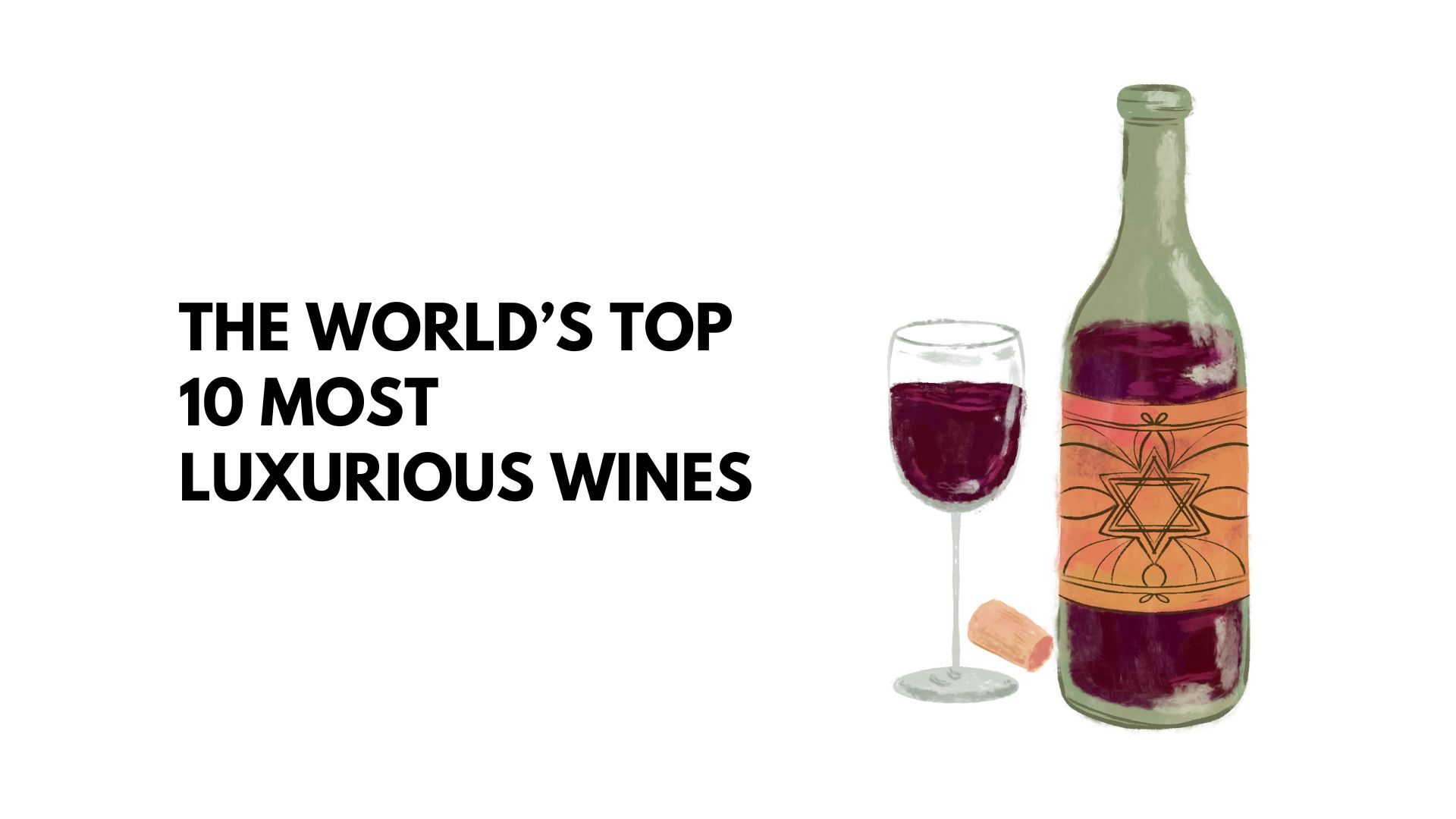
Page Contents
Expensive wines have been a part of the world for centuries, with some of the earliest recorded examples dating back to ancient Rome. However, the modern era of high-priced wines began in the mid-20th century, particularly with the emergence of the “cult wine” phenomenon in California in the 1970s. These wines, produced in limited quantities and highly sought after by collectors, often command prices in the thousands of dollars per bottle.
Today, expensive wines are produced and enjoyed all over the world, with prices driven by factors such as rarity, age, and prestige. In this article, we will see the history of wine production as well as the world’s top 10 most luxurious wines.
Introduction
Expensive wines are considered luxury items and are highly sought after by wine collectors, enthusiasts, and investors. The price of wine can be determined by various factors, including the quality of the grapes, the production process, the vintage year, and the rarity of the wine.
Some of the most expensive wines in the world include Domaine de la Romanée-Conti, Chateau Margaux, Screaming Eagle Cabernet, and Penfolds Grange. These wines can range from several thousand dollars per bottle to hundreds of thousands of dollars, and their prices are often determined by the limited quantities produced and the high demand from collectors and enthusiasts.
While expensive wines are often considered a status symbol and a display of wealth, they are also valued for their complex flavours and aromas, which develop over time and can be enjoyed by those with a discerning palate. Overall, expensive wines remain a niche market, but their popularity continues to grow among those who appreciate the art and craftsmanship behind the production of fine wine.
History of Wine
The history of wine dates back to ancient times, with evidence of wine production found in various regions of the world. The earliest evidence of wine production comes from Georgia, where winemaking dates back to at least 6000 BC. The Egyptians also produced wine, with evidence of wine production found in tombs dating back to 2500 BC. Wine was an important part of Egyptian culture and was used in religious ceremonies.
The Greeks and Romans also had a deep appreciation for wine. The Greeks believed that wine was a gift from the gods, and it played an important role in their mythology. The Romans, meanwhile, made wine an integral part of their daily lives, and they were known for producing some of the finest wines of their time.
During the Middle Ages, wine production continued to flourish in Europe. Monks played an important role in preserving winemaking traditions and techniques, and they were responsible for many of the innovations that improved the quality of the wine. Wine was also an important part of the economy, and many regions relied on wine production as a major source of income.
In the 16th and 17th centuries, wine production spread to the New World, with Spanish and Portuguese settlers bringing wine to the Americas. In North America, wine production began in Mexico, with the first vineyards planted in the 1520s. In South America, wine production began in Chile in the 1550s.
In the 18th and 19th centuries, wine production continued to expand, with new regions emerging as important wine producers. The French region of Bordeaux became one of the most important wine regions in the world, known for producing some of the finest wines. The Napa Valley in California also emerged as an important wine region in the 19th century, and it remains one of the top wine regions in the world today.
In the 20th century, advances in technology and transportation made it easier to produce and distribute wine on a global scale. New World wine regions, such as Australia and New Zealand, emerged as major producers, and traditional wine regions, such as France and Italy, faced increasing competition.
Today, wine is enjoyed by people all over the world, and it continues to be an important part of many cultures. Wine production has become more sophisticated, with winemakers using a variety of techniques to produce unique and high-quality wines. Wine tourism has also become popular, with many people travelling to different wine regions to sample the local wines and learn about winemaking traditions.
Overall, the history of wine is a rich and complex one, dating back thousands of years. From its origins in ancient civilizations to its current status as a global industry, wine has played an important role in human culture and continues to be an important part of our lives today.
Types of Wine
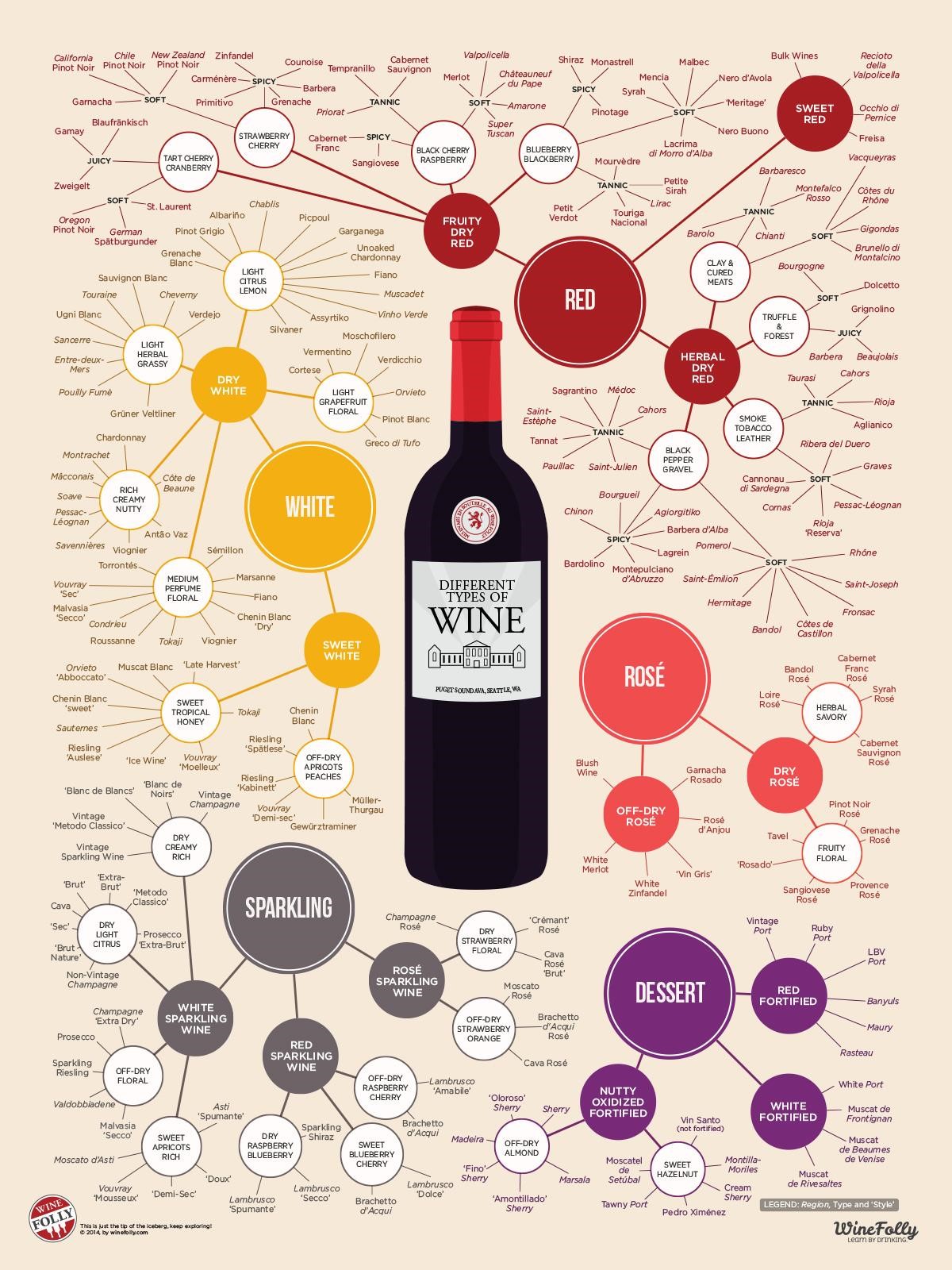
There are many types of wine, each with its unique characteristics, production processes, and flavour profiles. Here are some of the most familiar genres of wine:
- Red Wine: Made from red or black grapes, red wine is typically fermented with grape skins, which gives it its deep colour and tannins. Some popular red wine varieties include Cabernet Sauvignon, Pinot Noir, Merlot, Syrah, and Zinfandel.
- White Wine: Made from white or green grapes, white wine is fermented without the grape skins, resulting in a lighter colour and lower tannins. Popular white wine varieties include Chardonnay, Sauvignon Blanc, Riesling, Pinot Grigio, and Moscato.
- Rosé Wine: Often called “pink” or “blush” wine, rosé is made by allowing the grape skins to remain in contact with the juice for a short period, resulting in a pinkish colour. Some popular rosé varieties include Provence, White Zinfandel, and Tavel.
- Sparkling Wine: Carbonated wine that includes Champagne, Prosecco, Cava, and other types of bubbly. These wines undergo a secondary fermentation process in the bottle, resulting in carbon dioxide bubbles.
- Dessert Wine: Sweet, fortified wines are usually served after dinner. Some popular types of dessert wine include Port, Sherry, and Sauternes.
- Fortified wine: Wines that have had additional alcohol added to them during the production process. Examples include Port, Sherry, and Madeira.
- Organic and Natural Wine: Made without added chemicals or preservatives, these wines are becoming increasingly popular due to their sustainability and health benefits.
There are many more types of wine, each with its unique flavour profile and production process.
Causes of Wine
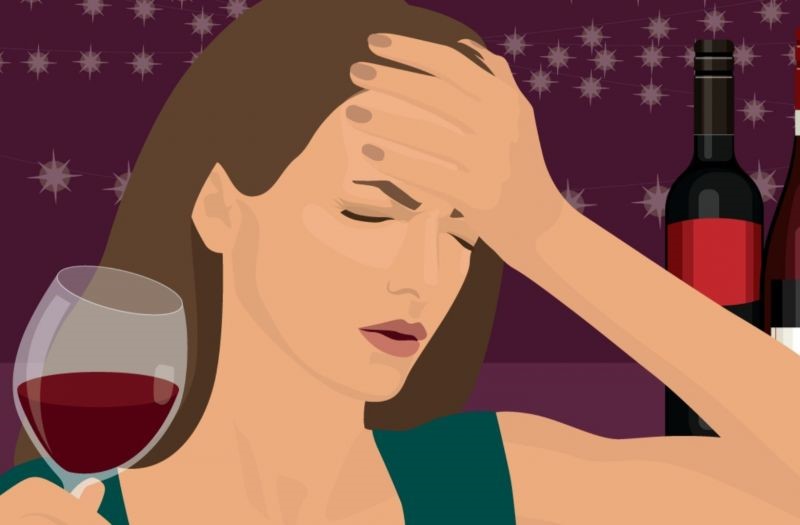
Wine is a modish alcoholic libation made from fermented grapes. It has been enjoyed by people for thousands of years and has become an integral part of many cultures around the world. While wine is primarily made from grapes, other fruits such as apples, berries, and plums can also be used. The process of winemaking involves a series of steps that lead to the production of wine.
The Following Are Some Of The Causes Of Wine:
- Grapes: The primary cause of wine is grapes. Grapes are used in making wine because they have a high sugar content, which is essential for the fermentation process. The sugar in the grapes is converted into alcohol by yeast, which is naturally present on the grapes' skins. The grape variety used in winemaking can greatly affect the taste and aroma of the resulting wine.
- Fermentation: Fermentation is a natural process that occurs when yeast consumes sugar and produces alcohol and carbon dioxide. During winemaking, grape juice is placed in a container and yeast is added to the juice. The yeast begins to consume the sugar in the juice and produce alcohol. This process continues until the yeast has consumed all of the available sugar or until the winemaker decides to stop fermentation by cooling the juice or adding a stabilizing agent.
- Climate: Climate is an important factor in the production of wine. Grapes require a specific climate to grow, and the conditions in which they grow can affect the flavour of the wine. For example, grapes grown in a cool climate will produce wine with higher acidity, while grapes grown in a warm climate will produce wine with lower acidity.
- Soil: The type of soil in which grapes are grown can also affect the flavour of the wine. Different soils have different mineral compositions, and these minerals can be absorbed by the grapes and affect the flavour of the resulting wine. For example, grapes grown in soil with a high iron content can produce wine with a metallic taste.
- Winemaking techniques: The techniques used in winemaking can also affect the flavour of the wine. For example, the type of container used for fermentation, such as stainless steel, oak barrels, or concrete vats, can affect the flavour and aroma of the wine. Additionally, the length of time the wine is aged and the temperature at which it is stored can also affect the flavour of the wine.
- Grape pests and diseases: Grape pests and diseases can have a significant impact on the production of wine. Pests such as grapevine moths and grape phylloxera can damage the grapes, while diseases such as powdery mildew and downy mildew can affect the quality of the grapes and the resulting wine.
In conclusion, wine is a complex product that is influenced by many factors, including the type of grapes used, the fermentation process, climate, soil, winemaking techniques,
and grape pests and diseases. The combination of these factors can lead to a wide range of flavours and aromas in the resulting wine.
Preventions
- When consumed orally, wine is most likely to be safe for most grownups when used in moderation (about two 5-ounce glasses daily). However, sipping more than this may be hazardous. Larger doses can result in blackouts, drowsiness, poor balance, diarrhoea, and other serious side effects.
- Long-term wine consumption can lead to a variety of serious health issues, which include heavy reliance, liver failure, or certain forms of cancer.
- When applied to the body There is insufficient reliable information to determine whether the wine is protected or what the potential side effects are.
- Alcohol is probably unsafe to consume during pregnancy. It can result in deformities and other severe damage to an unborn child. It has been linked to an increased risk of miscarriage, foetal alcohol syndrome, and developmental and behavioural disorders after birth. However, shirk belting alcohol if you’re expectant.
- Wine consumption has been linked to the onset of asthma attacks. This could be due to the presence of certain chemicals in wine, such as sulfa drugs and/or nitrites.
- Alcohol consumption can aggravate gastroesophageal reflux disease (GERD).
- Consuming alcohol can aggravate gout.
- Drinking alcohol may worsen heart conditions in people who have chest pain, heart problems, or an enlarged heart.
- Having three or more liquors per day can raise blood pressure and aggravate pre-existing high blood pressure.
- High triglyceride levels in the serum (hypertriglyceridemia): Alcohol consumption can exacerbate this condition.
- Alcohol can exacerbate insomnia.
- Alcohol consumption can exacerbate the liver disease.
Top 10 Most Luxurious Wines In The World
- Romanee-Conti Grand CRU (Year – 1945) (Worth USD 558,000)
- Screaming Eagle (Year – 1992) (Worth USD 500,000)
- Chateau Mouton-Rothschild (Year – 1945) (Worth USD 310,000)
- Chateau Cheval Blanc (Year – 1947) (Worth USD 304,374)
- Heidsieck (Year – 1907) (Worth USD 275,000)
- Chateau Lafite-Rothschild (Year – 1869) (Worth USD 230,000)
- Chateau Margaux (Year – 1787) (Worth USD 225,000)
- Penfolds Block 42 (Year – 2004) (Worth USD 168,000)
- Chateau Lafite (Year – 1787) (Worth USD 156,000)
- Chateau D’Yquem (Year – 1811) (Worth USD 117,000)
#1. Romanee-Conti Grand CRU (Year – 1945) (Worth USD 558,000)
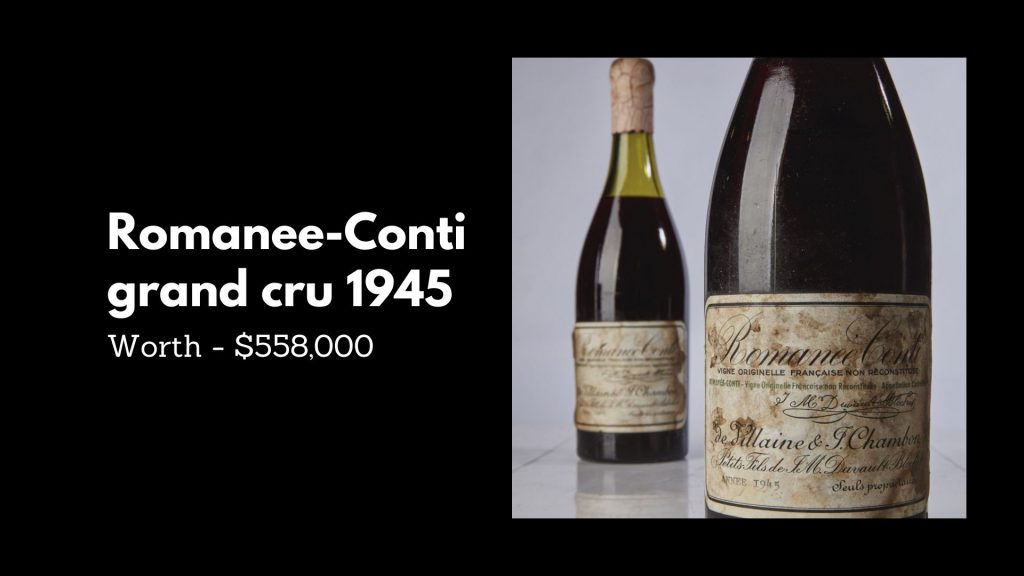
In 2018, the 1945 Domaine de la Romanée-Conti, Romanée-Conti Grand Cru broke all previous data when it sold for $558,000 at Sotheby's New York auction. With that price, it became not only the most highly-priced 750ml vial of Burgundy but also the most expensive liquor wine on the planet.
But what was it about this particular bottle that made it so expensive? Quality and scarcity are the short answers. The 1945 Domaine de la Romanée-Conti, Romanée-Conti Grand Cru is sourced from the 4.5-acre Romanée-Conti vineyard, which is known for producing high-quality red and white wines. Furthermore, because of the climate conditions that year, the wines were very concentrated, and production was extremely low. This indicates that only 600 vials were indeed made, and the majority of them are still in use today. Such enchanting quality and extreme rarity make the whole particular bottle well-deserving of its price tag, as well as number one on any list of the most expensive bottle of all time.
#2. Screaming Eagle (Year – 1992) (Worth USD 500,000)
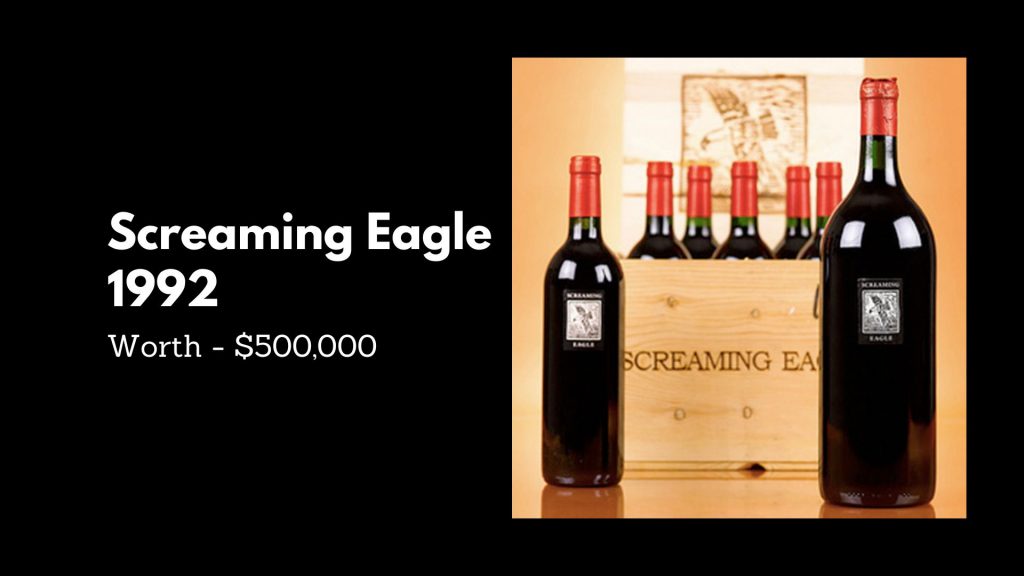
America has repeatedly demonstrated that it can generate wine on par with France and Italy. The 1992 Screaming Eagle Cabernet Sauvignon from Oakville, California was auctioned off for a whopping $500,000 during a charity fundraiser in the year 2000. Rarity and limited production aren't the only factors that influence its price. The wine is aged in 60% rye malt and is highly unstructured before bottling, giving it a distinct flavour and exceptional quality. An undeniably delicate bottle that rightfully carries the distinction of being one of the world's most expensive wines
Chateau Mouton-Rothschild (Year – 1945) (Worth USD 310,000)
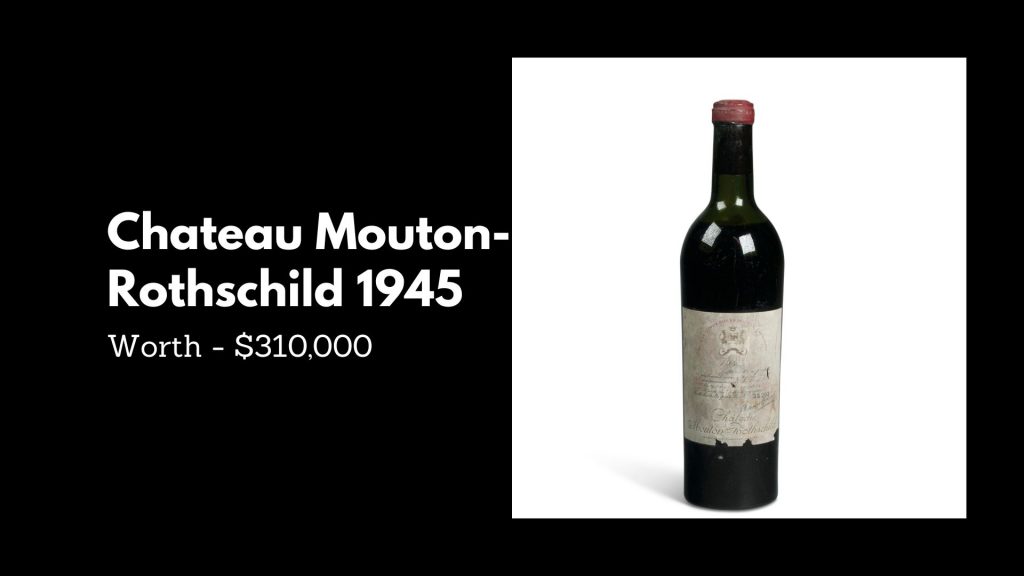
Still, it’s presumably because it is if the name seems close. This bottle emerges out from the vineyards of one of the world's wealthiest families, as Nathaniel Rothschild purchased the estate in 1853. Today, bottles from this vineyard are among the most costly in the world, and this unique Jeroboam of Chateau Mouton- Rothschild is no exception. The distinctive “V” in the label denotes the Allied Forces' victory in WWII in 1945.
A bottle that contained one of the best iconic wines of the 21st century would cost $310,700, with a glass costing around $8,631. A pricey wine with an undeniably exceptional taste and history.
#4. Chateau Cheval Blanc (Year – 1947) (Worth USD 304,374)
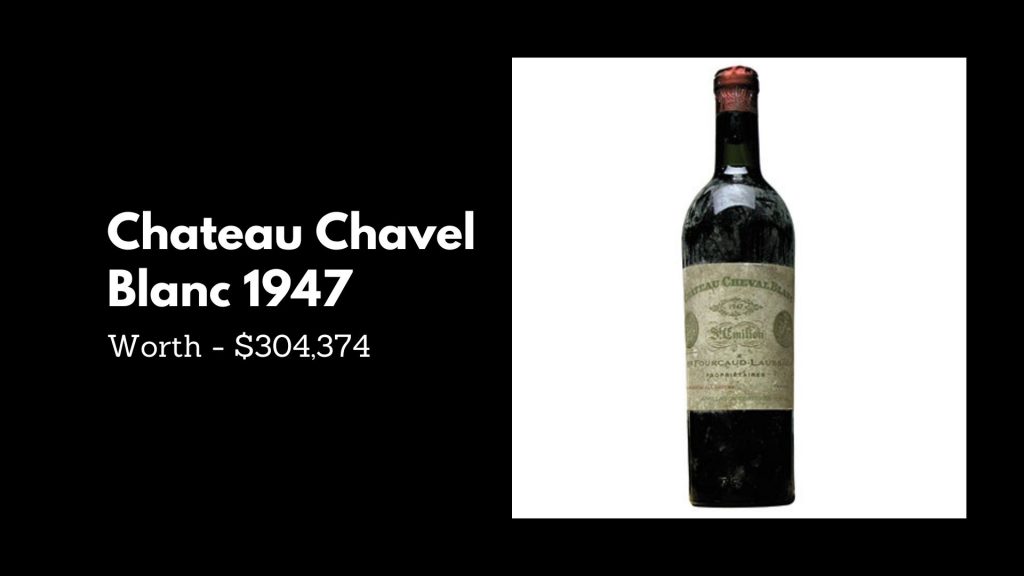
This 1947 Chateau Cheval Blanc from one of the world's most prestigious winemakers, Chateau Cheval Blanc, is widely considered to be the finest Bordeaux ever produced. But why is this so? The wine was required to be produced using primitive strategies plagued with technical faults and flaws due to extraordinarily severe weather during its production year. One would think that this would degrade the wine's quality, but instead, it produced a product with a flavour that will almost certainly never be emulated again. As a result, this 1947 Chateau Cheval Blanc retrieved a whopping $304,375 at Christie's in 2010 and grouted its place on the list of the most expensive brands ever produced
#5. Heidsieck (Year – 1907) (Worth USD 275,000)
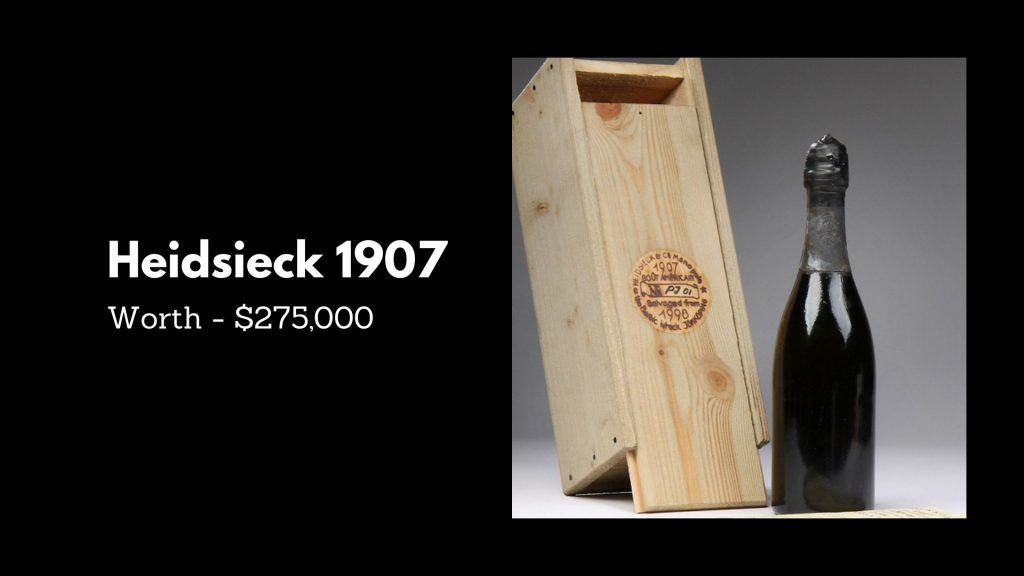
An expensive wine may be worth its price not only because of its durability or rarity but also because it conceals a story. Originally intended for Russia's last tsar, Nicholas II, this 1907 Heidsieck perished with the ship on which it was transported in 1916. What is the root cause? wreck from such a German submarine all through WWI. For 80 years, the bottle sat undisturbed somewhere at bottom of the extremely cold ocean, away from sunlight. The wreckage, thought to be lost to history, was noticed in 1997 and all 2,000 bottles were repurposed.
The unfavourable conditions may make this same component of this 1907 Heidsieck “unenjoyable,” but with such a history, it's hard not to want to add it to your collection.
#6. Chateau Lafite-Rothschild (Year – 1869) (Worth USD 230,000)
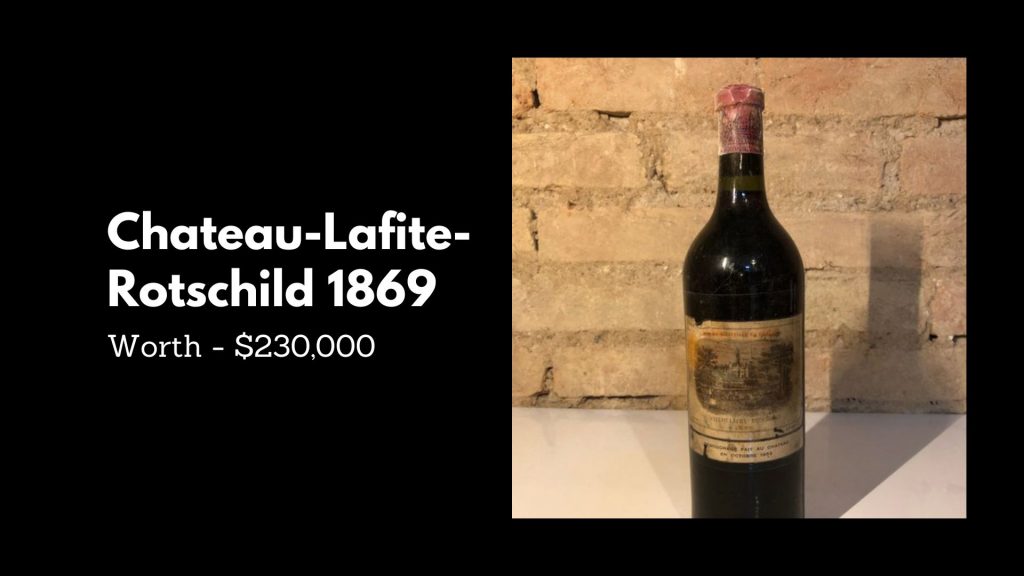
Chateau Lafite Rothschild 1896 is a Premier Grand Cru Clase Cabernet Sauvignon-style Chateau Pauillac from the Mendoc region.
Their wines are packed and pungent, with flavourful notes of cedar, cassis, and cigar box spice.
They remain among the top 1% of all French and Grenache wines.
The Wall Street Journal published a bidding process wherein the 3 bottles of Chateau Lafite Rothschild 1869 sold for 1.8 million dollars, with each bottle costing approximately $225,000.
#7. Chateau Margaux (Year – 1787) (Worth USD 225,000)
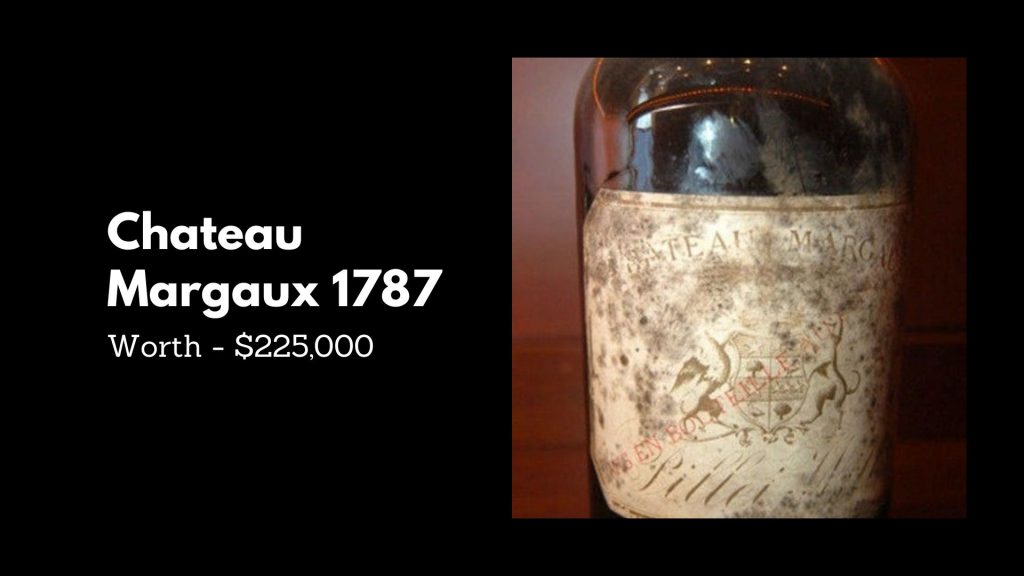
One more bottle with a fascinating backstory. This unique 1787 Chateau Margaux reflects the initials of a renowned oenophile, Thomas Jefferson. Yes, the third President of the USA was a known wine connoisseur who purchased this bottle while serving as a special envoy to France. William Solokin paid a whopping $225,000 for the bottle. Unfortunately, this fine and expensive wine ended tragically. Sorokin had brought the bottle to a Hotel Four Seasons for a dinner ceremony when a waiter kept bumping the table, shattering the bottle.
#8. Penfolds Block 42 (Year – 2004) (Worth USD 168,000)
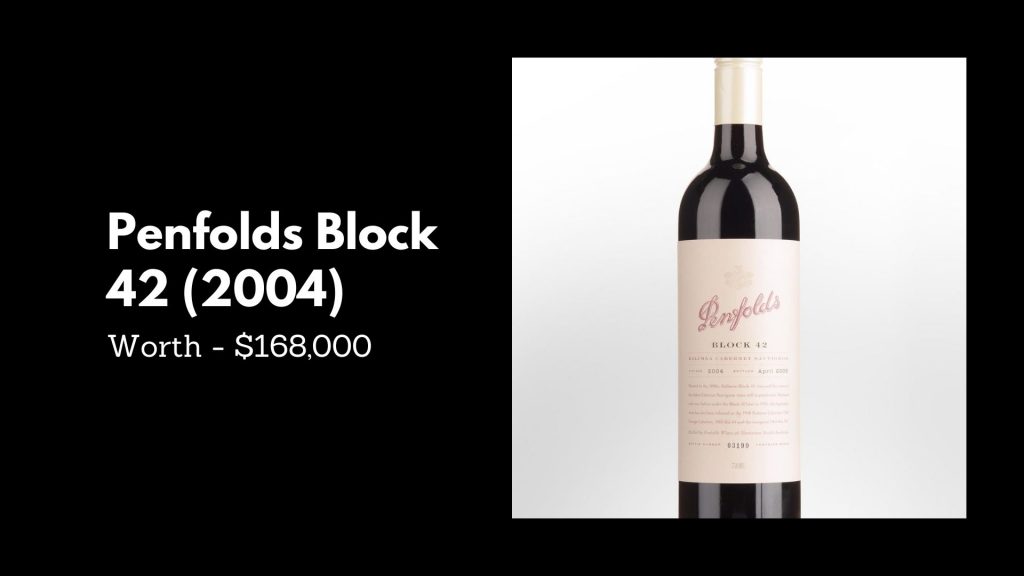
A bottle from the 2000s on a list of the finest expensive wines ever made? Yes, indeed. This is no customary wine. Consumption is a sensory experience in and of itself. The bottle is not in the traditional shape that we are all accustomed to. Rather, the wine is kept in ampoules that lack a cork or a screwcap. In assertion, there is no shield at all. The only way to consume the wine is to blow off the end. Veteran winemaker staff will accompany consumers to their location to assist with the process. The wine comes from Penfolds, South Australia's most well-known winery.
Block 42 Cabernet Sauvignon small wine bottles are currently the most pricey wines to be sold directly from a winery.
#9. Chateau Lafite (Year – 1787) (Worth USD 156,000)
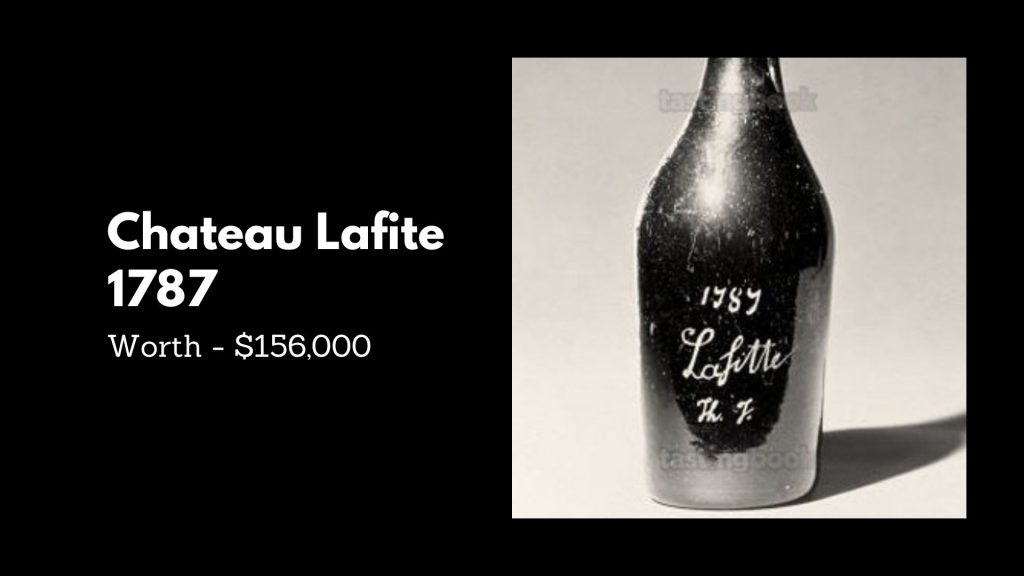
Further entries that were once possessed by Thomas Jefferson had a tragic ending. This 1787 Chateau Lafite was revealed in a Paris cellar 200 years after the death of the 3rd President. The bottle, etched with the President's initials, was eventually purchased for a whopping $156,450 by publisher Malcolm Forbes (yes, that Forbes) in 1985. Forbes put the bottle on show under halogen lights to show off his new possession. Because of the heat, the cork dried out and fell into the bottle, yielding a once legendary and costlier wine valueless.
#10. Chateau D’Yquem (Year – 1811) (Worth USD 117,000)
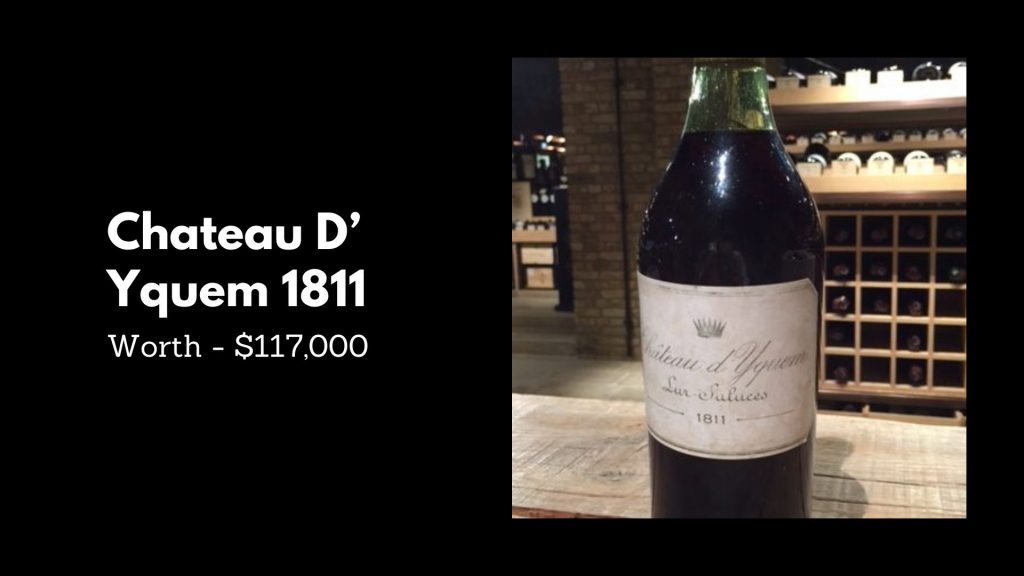
Chateau D'Yquem is a world-renowned Bordeaux winery that dates back to the 1500s. Chateau D'Yquem makes white wines, and their distinctively sweet flavour has managed to earn them the strongest designation of any white wine in the world, premier cru Superieur. The Chateau D'Yquem wines are so scarce because they use noble blight, a natural occurrence in which the grape species is invaded by a specific bacterium.
The grapes shrink back and produce a few drops of delectable wine nectar, which becomes the highly sought-after bottles of today.
A bottle of classic 1811 Chateau D'Yquem recently sold for $117,000 at auction.
Facts About Wine
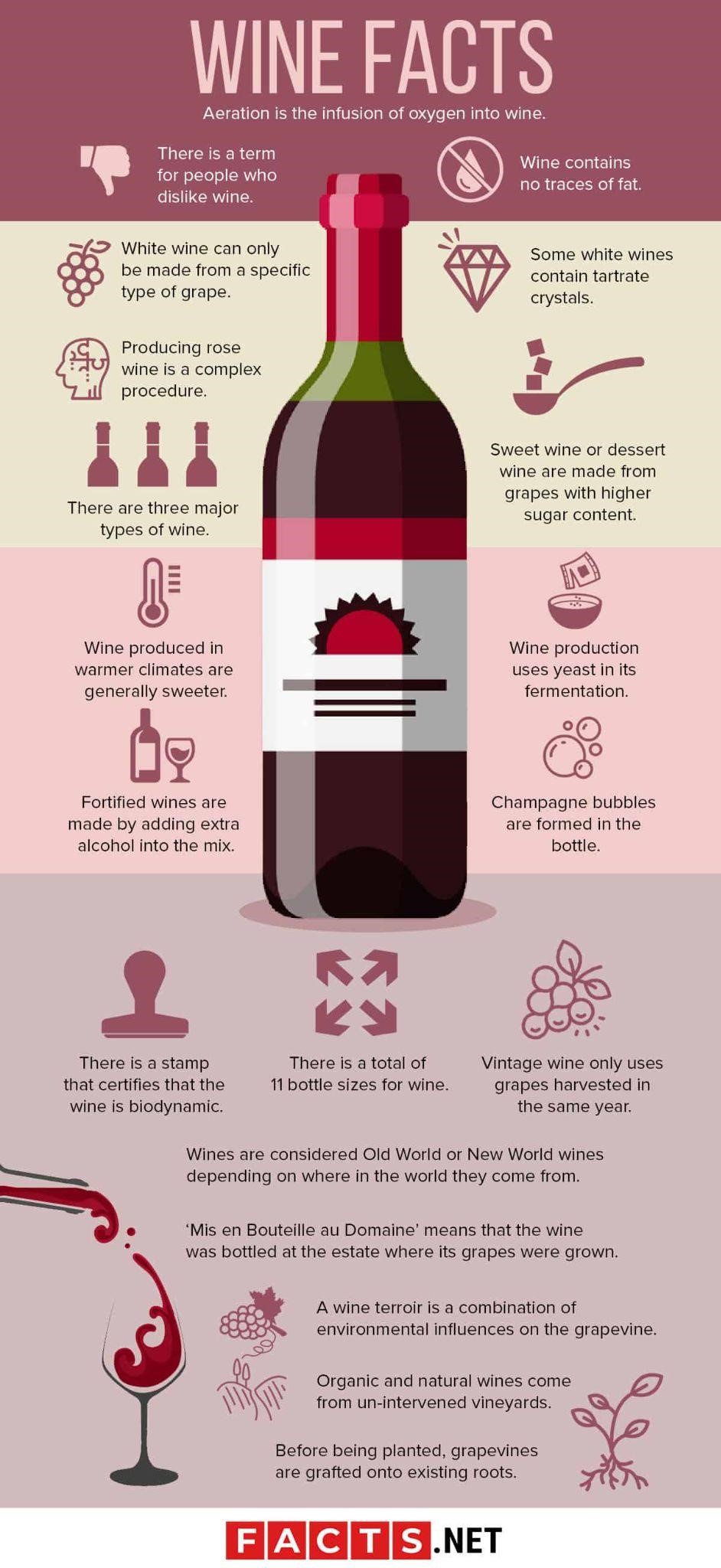
- A few individuals get a “fear of wine,” which is known as oenophobia.
- People used to drink wine rather than water to dampen their thirst centuries ago. Water wasn't always clean at the time, and natural fermentation, which occurs when the wine is created, could kill bacteria induced by typhi (salmonella) and cholera.
- To release the aromas of the wine, wine tasters “swirl” it in their glasses. They also don't fill the crystal or more than a third of the way to allow these aromas to accumulate.
- France, Spain, and Italy are the world's three most important wine producers. The United States (California) is fourth, with China in fifth place.
- The wine had earlier been stored in goatskin bags. Sir Kenelm Digby (1603-1665), an Englishman, concocted the deep green wine that we all know today.
- Wines are still more sophisticated than blood serums because they contain so many organic compounds.
- There seem to be 400 different Oak genera available for use as wine barrel wood.
Summary
Expensive wine can be an incredibly luxurious and special experience for many people. While the cost may seem intimidating at first glance, it is important to consider the quality and complexity of flavours found only in these bottles. An expensive bottle of wine can often offer a unique flavour profile that can't be achieved with cheaper alternatives.
It is also important to consider the unique experience that comes with enjoying such an indulgence. For many people, it can offer the perfect way to celebrate a milestone or mark a memorable occasion. Ultimately, it is up to the individual to decide if the cost of an expensive bottle of wine is worth the unique flavours, complexity and experience it offers
FAQ.
Domaine Leroy Musigny Grand Cru is the most expensive bottle of wine by a wide margin.
White wine can be kept for 1-2 years after the published expiry date. Red wine must be consumed within 2-3 years of the published expiry date. Cooking wine can be kept for 3-5 years after the published expiry date. Fine wine: 10-20 years if properly stored in a storage room
Because of its elevated amounts of flavonoids, Pinot Noir has been deemed the healthiest wine. It is produced from grapes with a thin layer and lumps of low sugar, calorie, and carbonation.
Georgia is widely regarded as the "cradle of wine," with archaeologists tracing the world's largest initially known wine creation to the folks of the South Caucasus in 6,000 BC.

Aruna Madrekar is a vibrant author who delves into the fascinating world of the most expensive things, presenting her discoveries in a manner that speaks to both aficionados and the everyday reader. Her commitment to making luxury and opulence accessible to all is evident in her easy-to-understand writing style. Aruna believes that behind every pricey tag lies a story worth telling, and she has dedicated her craft to unraveling these tales for her audience. When she's not immersed in her latest find, Aruna enjoys traveling and tasting unique cuisines from around the globe. Join her on her explorative journey and discover the true value behind the world's most coveted items.